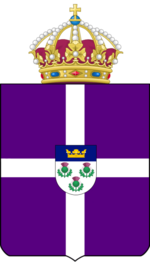Politics of Caldia: Difference between revisions
No edit summary |
m (1 revision imported) |
(No difference)
| |
Revision as of 04:25, 23 March 2019
This article is incomplete because it is pending further input from participants, or it is a work-in-progress by one author. Please comment on this article's talk page to share your input, comments and questions. Note: To contribute to this article, you may need to seek help from the author(s) of this page. |
 |
|---|
| This article is part of a series on the politics and government of Caldia |
|
|
Politics in Glytter take place in the framework of a parliamentary representative democratic constitutional monarchy. Executive power is exercised by the monarch and the Cabinet, led by the Taoiseach of Glytter. Legislative power is vested in both the government and the Royal Congress, elected within a multi-party system. The Judiciary is independent of the executive branch and the legislature.
Constitutional development
Constitution in 1814, Instrument for Governance Act of 1857, Instrument for Governance Act of 1965
Executive branch
Glytter is a unitary constitutional monarchy with a parliamentary system of government, wherein the King of Glytter is the head of state and the Taoiseach is the head of government.
The Monarch officially retains executive power. However, following the introduction of a parliamentary system of government, the duties of the Monarch have since become strictly representative and ceremonial such as the formal appointment and dismissal of the Taoiseach and other ministers in the executive government. Accordingly, the Monarch is commander-in-chief of the Glytteronian Armed Forces, and serves as chief diplomatic official abroad and as a symbol of unity. Kenneth IV of the House of MacIconnich-Sartoux was crowned King of Glytter in 2010. Princess Mary Victoria, Duchess of Snarksburgh is the heir designate to the throne and the Kingdom. A system of tainistry is in place, allowing the Monarch to appoint their own heir.
Legislative branch
The Tionól of Glytter, often simply the Tionól, is the supreme legislative body in Glytter. It alone possesses legislative supremacy and thereby ultimate power over all other political bodies in Glytter. Its head is the Monarch of Glytter (currently King Kenneth IV) and its seat is Carrowdun Palace in Spálgleann. The legislature is bicameral, consisting of an upper house (the Seanad Glítteann) and a lower house (the Comhthionól Náisiúnta). The monarch forms the third component of the legislature (the King-in-Congress).
The Comhthionól Náisiúnta (National Assembly) is the lower house, and principal chamber, of the Tionól. It is directly elected at least once every five years under the system of proportional representation by means of the single transferable vote (STV). Its powers are similar to those of lower houses under many other bicameral parliamentary systems and it is by far the dominant branch of the Tionól. Subject to the limits imposed by the Constitution of Glytter, it has power to pass any law it wishes, and to nominate and remove the Taoiseach. Members of the Comhthionól are known as Teachtaí Comhthionól (TCs). It was created following the Silent Revolution through the Instrument for Governance Act of 1857.
The Seanad Glítteann (Senate of Glytter) is the upper house of the Tionól. It is commonly called the Seanad or Senate and its members senators (seanadóirí in Ghaillish, singular: seanadóir). In 1814, the Seanad was established by the Constitution of Glytter and the first democratic national elections were held in the country that same year. Unlike the Comhthionól, it is only partially directly elected. More than half of its members are chosen through various methods, typically rooted in appointment. Its powers are considerably more limited than those of the Comhthionól and it can only delay laws with which it disagrees, rather than veto them outright.
Teachtaí Comhthionól (TCs) and elected Seanadóirí serve for five year terms until elections are held once again. The last Seanad election was on 26 May 2016 and the last Comhthionól was on 12 June 2017. The appointed Seanadóirí do not stand for reelection and serve their term either for life or until they are dismissed by the Taoiseach or the other respective nominating bodies.